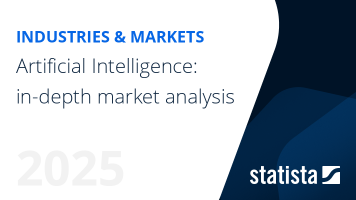Speech Recognition - United Arab Emirates
United Arab Emirates- The market size in the Speech Recognition market is projected to reach US$93.75m in 2025.
- The market size is expected to show an annual growth rate (CAGR 2025-2031) of 40.25%, resulting in a market volume of US$713.53m by 2031.
- In global comparison, the largest market size will be United States (US$1.98bn in 2025).
Definition:
Speech recognition, as a part of computer vision, focuses on converting spoken language into written text and/or commands. It involves the use of algorithms and machine learning models to analyze and interpret audio signals, recognizing and transcribing the spoken words into textual form. Speech recognition systems utilize techniques such as acoustic modeling, language modeling, and neural networks to accurately convert spoken language into written text. This technology has widespread applications, including voice assistants, dictation software, transcription services, call center automation, and hands-free control of devices, facilitating natural and efficient human-machine communication through spoken language.
Additional Information:
The market comprises two key performance indicators: market sizes and market sizes by industry. Market sizes are generated by the funding amount of Computer Vision companies. Key players of the market include companies such as Nvidia, Intel or IBM.
For more information on the data displayed, use the info button right next to the boxes.
- Technologies that convert human speech into written text or computer commands, such as automatic speech recognition (ASR)
- Products and services that use speech recognition technology, such as virtual assistants, transcription software, and language translation tools.
- Technologies that do not rely on speech as an input, such as text-based chatbots and image recognition software
- Products and services that do not use speech recognition technology, such as physical goods and traditional customer service support.
Market Size
Notes: Data was converted from local currencies using average exchange rates of the respective year.
Most recent update: Oct 2025
Source: Statista Market Insights
Notes: Data was converted from local currencies using average exchange rates of the respective year.
Most recent update: Oct 2025
Source: Statista Market Insights
Analyst Opinion
Speech recognition has gained a lot of traction in recent years. The integration of voice assistants and smart speakers into various devices and platforms to provide users with seamless voice-controlled experiences in their homes, cars, and workplaces is a notable trend. Another development is the advancement of automatic speech recognition (ASR) systems using deep learning models. There is also a growing emphasis on developing multilingual and code-switching speech recognition systems to cater to the diverse linguistic needs of global users, enabling more inclusive and accessible voice-based interactions.
The increasing demand for speech recognition technology across various industries, such as healthcare, banking, and retail, is a major growth factor for the speech recognition market. The advancement of AI and machine learning technologies has led to the development of more accurate and reliable speech recognition systems, which is expected to further boost market growth.
The Speech Recognition market is expected to continue its growth at a CAGR of 16.3% from 2023 to 2030. The increasing demand for speech-based virtual assistants and the growing adoption of speech recognition technology in the healthcare industry are expected to be the primary drivers of market growth.
Global Comparison
Notes: Data was converted from local currencies using average exchange rates of the respective year.
Most recent update: Oct 2025
Source: Statista Market Insights
Methodology
Data coverage: The data encompasses B2B, B2G, and B2C enterprises. Figures are based on the funding values from different industries for the market.
Modeling approach / Market size:Market sizes are determined through a top-down approach with a bottom-up validation, building on a specific rationale for each market. As a basis for evaluating markets, we use annual financial reports, funding data, and third-party data. In addition, we use relevant key market indicators and data from country-specific associations such as GDP, number of internet users, number of secure internet servers, and internet penetration. This data helps us estimate the market size for each country individually.
Forecasts:In our forecasts, we apply diverse forecasting techniques. The selection of forecasting techniques is based on the behavior of the relevant market. For example, the S-curve function and exponential trend smoothing are well suited to forecast digital products and services due to the non-linear growth of technology adoption. The main drivers are the level of digitalization, the number of secure internet servers, and the revenue of the Public Cloud market.
Additional Notes: The data is modeled using current exchange rates. The impact of the COVID-19 pandemic and the Russian-Ukraine war are considered at a country-specific level. The market is updated twice a year. In some cases, the market is updated on an ad-hoc basis (e.g., when new, relevant data has been released or significant changes within the market have an impact on the projected development). Data from the Statista Consumer Insights Global survey is weighted for representativeness.
Key Market Indicators
Notes: Based on data from IMF, World Bank, UN and Eurostat
Most recent update: Jan 2025
Source: Statista Market Insights
Explore more high-quality data on related topic
Artificial intelligence (AI) worldwide - statistics & facts
Explore more high-quality data on related topic
Artificial intelligence (AI) in the U.S. - statistics & facts
Contact


+44 (0)20 8189 7000
Mon - Fri, 9:30am - 5pm (GMT)

Mon - Fri, 10:00am - 6:00pm (JST)

+1 212 419-5774
Mon - Fri, 9am - 6pm (EST)

+65 6995 6959
Mon - Fri, 9am - 5pm (SGT)



